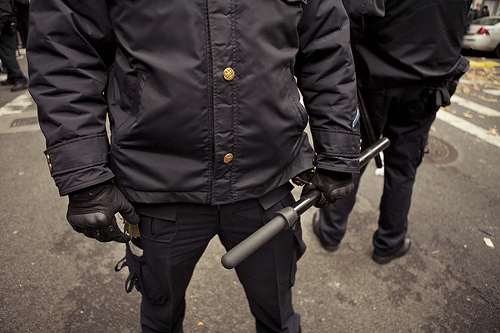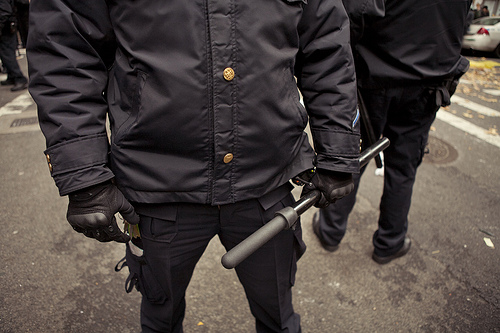 Photo: Jessica LehrmanOn Oct. 11, 2011, I asked the mayor of Baltimore to sleep with me. I challenged her to spend one night outside in front of City Hall in solidarity with Baltimore’s 4,000 homeless residents. It was a long shot, I knew. My good intentions notwithstanding, she would likely decline. But even I was surprised by the police helicopter — and the response it would elicit from my young companions.
Photo: Jessica LehrmanOn Oct. 11, 2011, I asked the mayor of Baltimore to sleep with me. I challenged her to spend one night outside in front of City Hall in solidarity with Baltimore’s 4,000 homeless residents. It was a long shot, I knew. My good intentions notwithstanding, she would likely decline. But even I was surprised by the police helicopter — and the response it would elicit from my young companions.
Once a month, I write a column called “Where I Come From” for Baltimore City Paper. I use the space to moderate a conversation between races, between generations, and between the haves and have-nots. So when I found out that Mayor Stephanie Rawlings-Blake, members of the nonprofit community, and others had committed to ending homelessness in Baltimore within this decade, I began to think of ways I might help. One of the biggest problems, as I saw it, was how few people knew about the effort, so I put up the website One Night Stand for Homelessness, issued my friendly challenge, and encouraged everyone to join us.
Within 48 hours, hundreds of people hit the site, dozens volunteered to sleep out, and, per my suggestion, a number of them emailed the mayor, encouraging her to participate. When I learned that local college students were already planning a sleep-out during National Hunger and Homelessness Awareness Week, I quickly pivoted from planning a small event of my own to supporting their much bigger effort. They called it A Bench is Not A Bed, and it was scheduled for last Saturday, Nov. 19.
As the night of the event approached, it was impossible to mention sleeping outside for some social cause without thinking about the Occupy movement. Baltimore’s Occupy encampment is just blocks from City Hall, and despite the activists’ non-violent tactics, they presented a public relations challenge for the newly elected mayor. The anti-homelessness rally must have added to her stress.
Still, on Saturday night, things got off to a beautiful start. Approximately 300 people, mostly students, some people experiencing homelessness, plus concerned individuals like myself, ate together, heard from advocat es, and participated in teach-ins. Students gave away sleeping bags to those who wouldn’t have a home to go to the next morning.
The high point of the night came halfway through the program as more than 100 Occupy demonstrators, including a group en route from New York to D.C. on foot, arrived, shouting, holding signs, and banging drums. It was like watching the cavalry ride in with reinforcements, but this was also when the police presence increased noticeably. Police car lights flashed as the marchers approached City Hall, and for the next few hours, the helicopter did loops around the downtown area.
The Occupy Wall Street marchers moved off to the Occupy Baltimore encampment, but the police kept coming. It wasn’t looking good. We had tried to get a permit to spend the night, but as in past years, the city had refused, giving us permission to gather only until 9 p.m. In the past, the police had allowed the group to sleep over, checking in occasionally but effectively extending the permit well into the following morning. Not this year.
During the last 30 minutes before the permit expired, more police appeared, and shortly after 9 p.m., an officer used the PA system in his squad car to announce that we had to leave. Days earlier, some students had talked about getting arrested if it came to that, and Occupy Baltimore had already agreed to take in those who wanted to sleep out but couldn’t afford to go to jail. But in the end, the organizers decided that with few media representatives in attendance, imprisonment might not be worth the cost. So we packed up. Most people left, but a few dozen, confused and dispirited, moved to Occupy.
We looked like refugees. Students who less than two hours earlier were happy and engaged stretched out on their sleeping bags in stunned silence, shocked at having been displaced.
Eventually, a conversation began. Some students expressed surprise at how insistent the police were that we leave. One young woman recounted how an officer tried to intimidate her by insisting that jail was not a safe place “for someone like you.” And it was at about that time that disappointment turned to anger.
Against the backdrop of a massive, army-style tent, Michael Jefferson, a polite, bespectacled sociology major from Annapolis, Md., summarized what a lot of students seemed to be feeling.
“When we were threatened with arrest, at first, I actually wasn’t surprised. I thought, ‘That’s just how it is,'” he told me later. “But [soon] I started to feel sick. Over 100 students had gathered to learn about homelessness and show their community they care, and for this we were threatened with incarceration. We had hoped that some city officials would join us … but instead, all they offered was punishment.”
Jefferson called what happened Saturday night “a formative experience.” “It’s a perverse world where public acts of compassion are grounds for arrest,” he said. “I … felt like we saw a dark side of Baltimore city politics.”
We did. The big question now is how young people like Jefferson in cities around the country will respond.
My grandmother grew up in segregated South Carolina. Her generation marched with Dr. Martin Luther King. My mom was raised during the Black Power era. But me? I’m 31. My contemporaries and I didn’t have a movement. As I helped promote the sleep-out, I was impressed that a group of people half a generation younger than me already had some community organizing experience before I thought to make my own statement.
These young men and women watched the World Trade Center burn, saw our country entangled in two major wars while they were learning algebra, helped elect the first black president, and now struggle with how difficult it is for him to do the work they hoped he would. So it’s no wonder they’re hitting the streets and coming up with their own answers.
During Baltimore’s recent demonstrations, there has been no police brutality like the pepper spray incident at UC Davis. No one’s been dragged off. No tents have been torn down. Not yet. But this is how movements spread: Here, as in other parts of the country, local officials are turning young people into victims, once passive observers into protesters, and a new generation of activists into battle-hardened agents of change.



